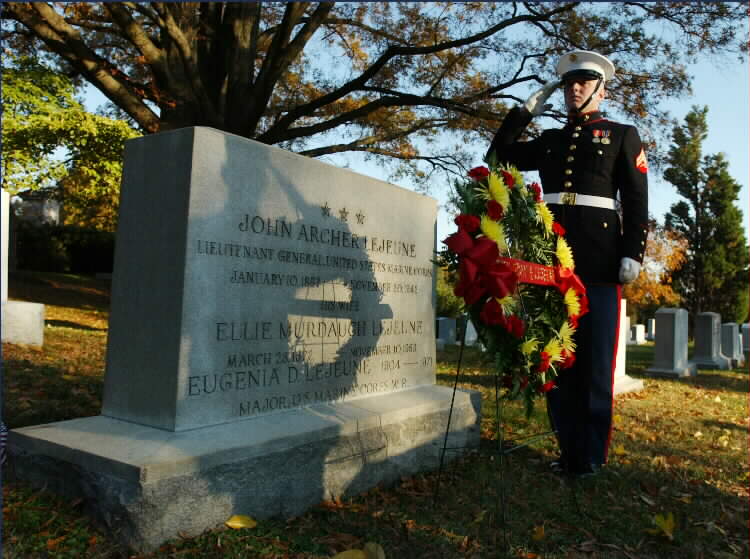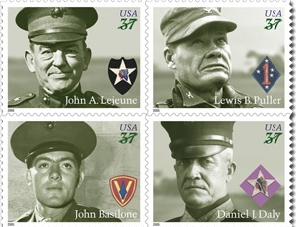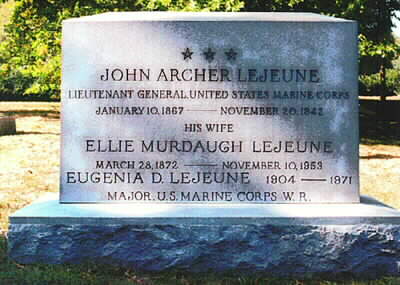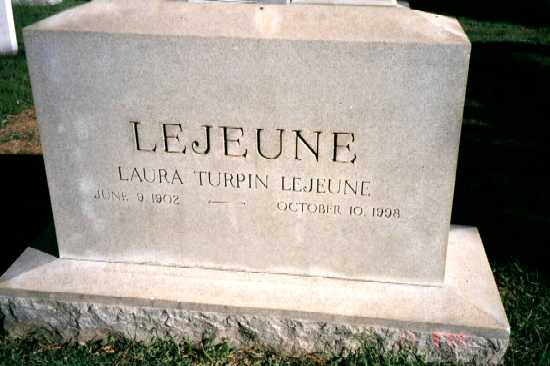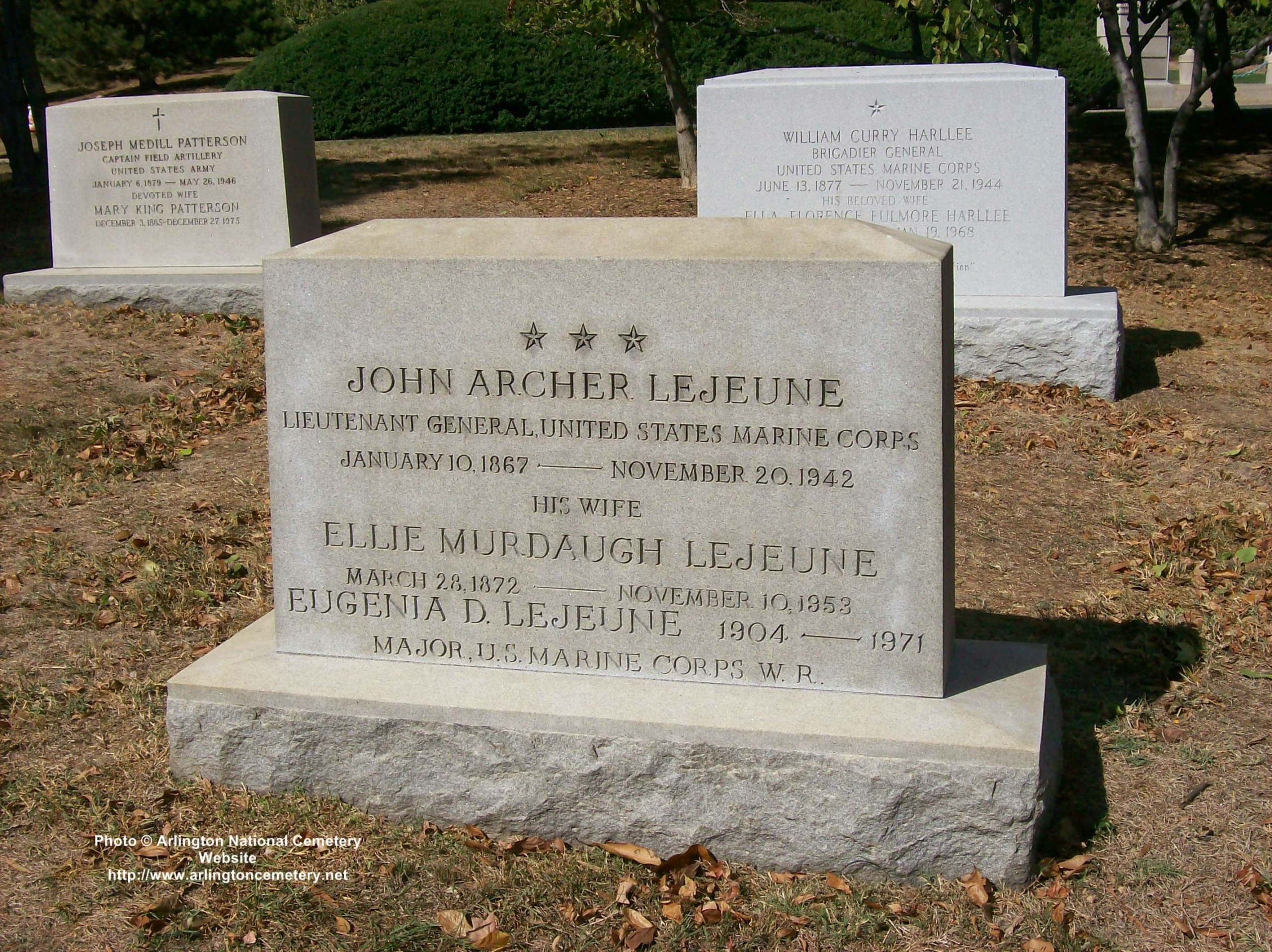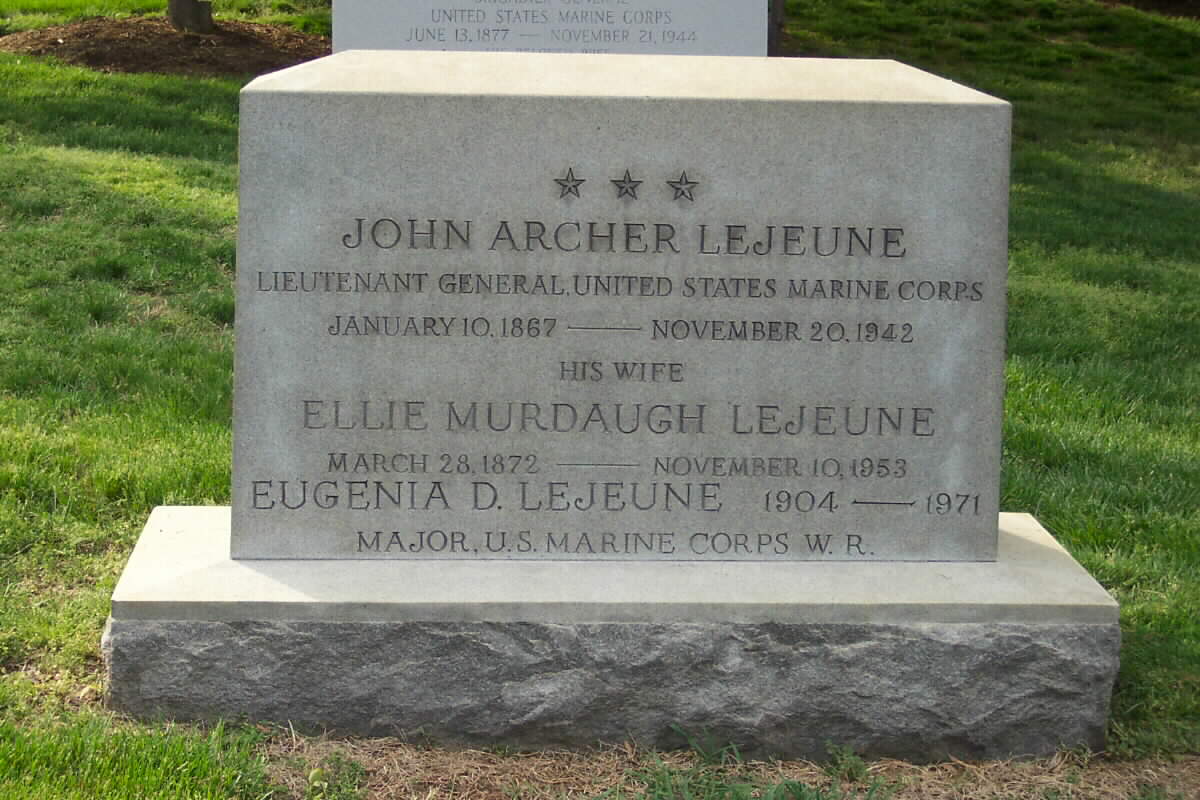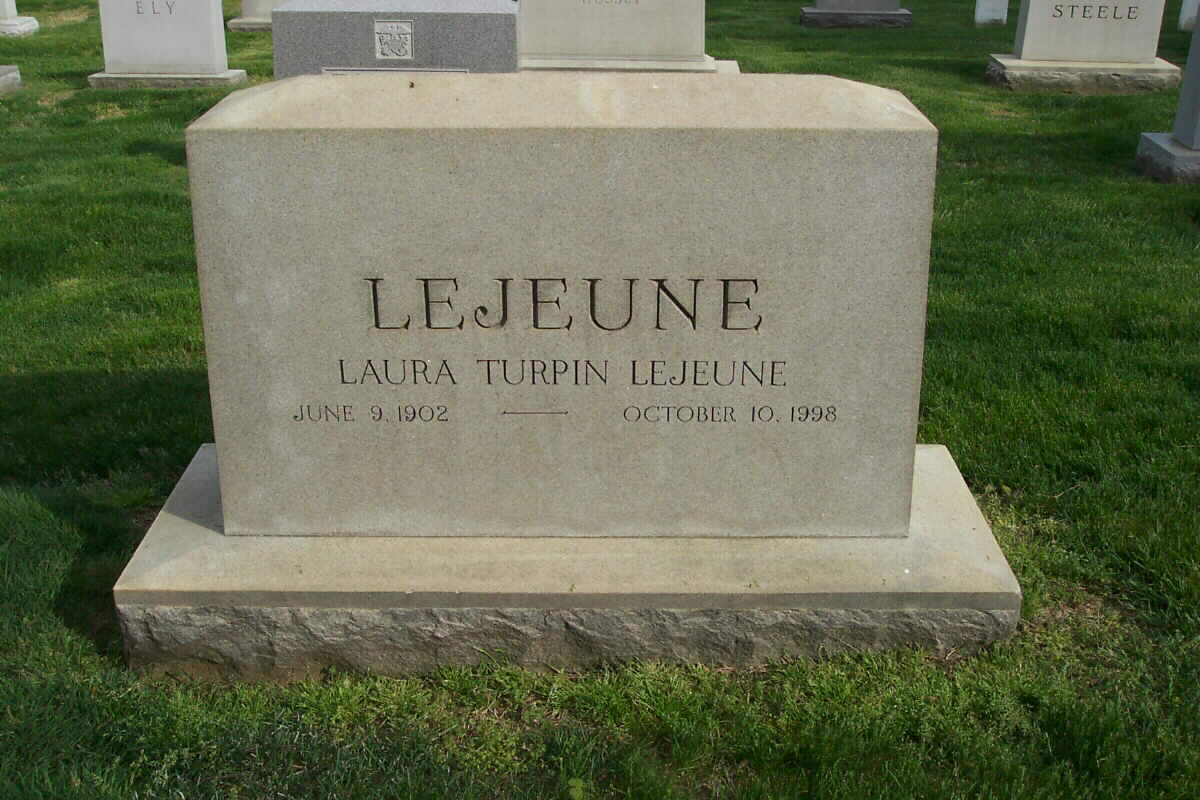Corporal David Rakes, Bravo Company body bearer, salutes the grave of Lieutenant General John A. Lejeune,
13th Commandant of the Marine Corps, during a wreath laying ceremony at Arlington National Cemetary,
November 10, 2005
Distinguished Marines (4):
The achievements of John Basilone, Daniel J. Daly, John A. Lejeune and Lewis B. Puller—four legendary Marines who served with bravery and distinction during the 20th century—will be immortalized on postage stamps next year:
• The John Basilone stamp features a detail of a 1943 photograph of Basilone and the insignia of the 5th Marine
Division. Basilone served and died with the 1st Battalion, 27th Marine Regiment, 5th Marine Division during the
invasion of Iwo Jima in February 1945.
• The Daniel J. Daly stamp features a detail from a circa 1919 photograph of Daly and the insignia of the 73rd
Machine Gun Company, which is a variation on the Army’s 2nd Infantry Division insignia. During World War I,
Daly served as a Marine with the 73rd Machine Gun Company in the 2nd Infantry Division.
• The John A. Lejeune stamp features a detail from a circa 1924 photograph of Lejeune. The stamp also depicts the
insignia of the Army’s 2nd Infantry Division, which Lejeune commanded during World War I.
• The Lewis B. Puller stamp features a photograph of Puller at Koto-ri, Korea, in 1950, and the insignia of the 1st
Marine Division. Puller was a battalion commander and regimental commander with the 1st Marine Division
during World War II and the Korean War.
Courtesy of the United States Marine Corps:
Lieutenant General John A. Lejeune, often referred to as “the greatest of all Leathernecks,” during his more than 40 years service with the Marine Corps, led the famed Second Division (Army) in World War I, and was Major General Commandant of the Marine Corps from June 1920 to March 1929.
John Archer Lejeune was born at Pointe Coupee, Louisiana on 10 January 1867. He was educated at Louisiana State University, Baton Rouge, from which he was graduated with a B.A. degree. Subsequently he secured an appointment as a midshipman at the U.S. Naval Academy, from which he was graduated in 1888.
At the expiration of a two-year cruise as a cadet midshipman he was commissioned a second lieutenant in the Marine Corps on 1 July 1890, and during the succeeding years saw action in the Spanish-American War aboard the USS Cincinnati.
In the fall of 1903 General Lejeune, then a major, was dispatched to Panama with a battalion of Marines when conditions had become critical through the revolution against Columbia. He returned to Panama three years later following a brief tour of duty at the Marine Barracks in Washington, D.C.
During the following years he was transferred to duty in the Philippine Islands, arriving in May 1907. While there he commanded the Marine Barracks, Navy Yard, Cavite, and later the First Brigade of Marines. He was detached to the United States 8 June 1909.
His next tour of foreign shore duty found the general, then a Lieutenant Colonel, in Cuba with the Second Provisional Brigade Marines from May 1912 to December of the same year. After a short period in the United States, he was again detached to expeditionary service in Cuba in February 1913, this time with the Second Brigade at Guantanamo Bay.
In November 1913, he sailed from New York with the Second Advanced Base Regiment, his ultimate destination Vera Cruz, Mexico, where he landed with his unit in April of 1914. He returned home in December 1914, this time to report to Marine Corps Headquarters in Washington, D.C. to become assistant to the Major General Commandant of the Marine Corps.
With the outbreak of World War I, General Lejeune assumed command of the newly constructed Marine Barracks, Quantico, Virginia. His overseas service was, however, inevitable, and in June 1918, arrived at Brest, France.
Upon reporting to the commander of the American Expeditionary Forces, he was assigned to command a brigade of the 32nd Division and assumed command of the Fourth Brigade of Marines of the Second Division immediately following the attack of the division in the Soissons offensive.
On 28 July 1918, General Lejeune assumed command of the Second Division and remained in that capacity until August 1919, when the unit was demobilized. He was the first Marine officer to hold an Army divisional command, and following the Armistice he led his division in the march into Germany.
During that war he was recognized by the French Government as a strategist and leader, as evidenced by the Legion of Honor, and the Croix de Guerre bestowed upon him by that people. From General John J. Pershing he received the Distinguished Service Medal. The Navy Distinguished Service Medal was conferred upon him when he returned to the United States following the occupation of Germany.
In October 1919 he again was appointed Commanding General, Marine Barracks, Quantico, Virginia, prior to his appointment as Major General Commandant of the Marine Corps on 30 June 1920. Subsequent to that time he several times left his Headquarters at Washington for tours of inspection in Haiti, Santo Domingo, Cuba, Puerto Rico, to the West Coast and elsewhere.
Upon the expiration of his second term as Commandant, General Lejeune indicated his desire not to retire from the Marine Corps, but was relieved as Commandant in March 1929. The following November of that year, on the 10th day of the month, he retired in order to accept the position of superintendent of the Virginia Military Institute, serving there until poor health necessitated his resignation in October 1937. In February 1942 he was advanced to the rank of lieutenant general on the Marine Corps retired list.
General Lejeune succumbed on 20 November 1942 at the Union Memorial Hospital, Baltimore, Maryland, and was interred in the Arlington National Cemetery with full military honors.
Today, Camp Lejeune, North Carolina bears not only the name of a Marine officer, but the name of one of the ablest officers of the American military forces, and one of the most distinguished soldiers of World War I.
NOTE: The General’s grandson, James Blair Glennon, Colonel, United States Marine Corps, is also buried in Arlington National Cemetery.
Today, Camp Lejeune, North Carolina, bears not only the name of a Marine Corps officer, but the name of one of the ablest officers of the American military forces, and one of the most distinguished soldiers of World War I.
He is buried in Section 6 of Arlington National Cemetery. His wife, Ellie Murdaugh Lejeune (March 28, 1877-November 10, 1953) and his daughter, Eugenia D. Lejeune, Major, United States Marine Corps Reserve (1904-1971), are buried with him.
LEJEUNE, LAURA TURPIN
On Saturday, October 10, 1998, in Virginia Beach, Virginia, the daughter of the late Lieutenant General John A. and Ellie Murdaugh Lejeune; beloved aunt of Colonel James B. Glennon, Jr., USMC (Retired.) of Arlington, Virginia. Also survived by nine great nieces and nephews. Friends may gather on Thursday, October 22, at 2:15 p.m. at the Administration Building at Arlington National Cemetery. Graveside services will be held at 3 p.m.
LEJEUNE, JOHN ARCHER
LIEUT GENERAL U S MARINE CORPS RETIRED
- VETERAN SERVICE DATES: Unknown
- DATE OF DEATH: 11/20/1942
- DATE OF INTERMENT: 11/23/1942
- BURIED AT: SECTION 6 SITE 5682
- ARLINGTON NATIONAL CEMETERY
Michael Robert Patterson was born in Arlington and is the son of a former officer of the US Army. So it was no wonder that sooner or later his interests drew him to American history and especially to American military history. Many of his articles can be found on renowned portals like the New York Times, Washingtonpost or Wikipedia.
Reviewed by: Michael Howard

